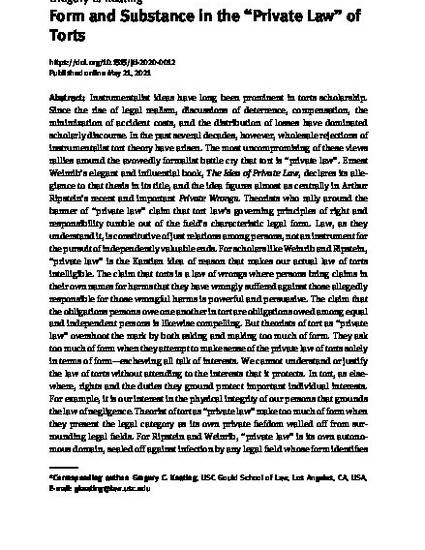
Article
Form and Substance in the "Private Law" of Torts
Journal of Tort Law
(2021)
Abstract
Instrumentalist ideas have long been prominent in torts scholarship. Since the rise of legal realism, discussions of deterrence, compensation, the minimization of accident costs, and the distribution of losses, have dominated scholarly discourse. In the past several decades, however, wholesale rejections of instrumentalist tort theory have arisen. The most uncompromising of these views rallies around the avowedly formalist battle cry that tort is “private law”. Ernest Weinrib’s elegant and influential book, The Idea of Private Law, declares its allegiance to that thesis in its title, and the idea figures almost as centrally in Arthur Ripstein’s recent and important Private Wrongs. Theorists who rally around the banner of “private law” claim that tort law’s governing principles of right and responsibility tumble out of the field’s characteristic legal form. Law, as they understand it, is constitutive of just relations among persons, not an instrument for the pursuit of independently valuable ends. For scholars like Weinrib and Ripstein, “private law” is the Kantian idea of reason that makes our actual law of torts intelligible. The claim that torts is a law of wrongs where (1) persons bring claims in their own names for (2) harms that they have wrongly suffered against (3) those allegedly responsible for those wrongful harms is powerful and persuasive. The claim that the obligations persons owe one another in tort are obligations owed among equal and independent persons is likewise compelling. But theorists of tort as “private law” overshoot the mark by both asking and making too much of form. They ask too much of form when they attempt to make sense of the private law of torts solely in terms of form—eschewing all talk of interests. We cannot understand or justify the law of torts without attending to the interests that it protects. In tort, as elsewhere, rights and the duties they ground protect important individual interests. For example, our pressing interest in the physical integrity of our persons grounds the law of negligence. Theorist of tort as “private law” make too much of form when they present the legal category of tort as its own autonomous domain, sealed off against infection by any legal field whose form identifies it as “public law”. In our law, the private law of torts cooperates and competes with public law institutions as a response to the pervasiveness of accidental harm in an industrial and technological society. Tort is one institutional instrument available to us to secure diverse, important interests against interference and impairment. Establishing rightful relations among free and equal persons in civil society requires that institutions protect persons’ urgent interests, not just establish their formal independence. The theoretical understanding that we need will recognize that we misunderstand even the private law of torts itself if we sever it entirely from forms of collective responsibility for avoiding and repairing accidental harm. Our private law of torts competes and cooperates with these bodies of law and cannot be understood in isolation from them.
Keywords
- private law,
- public law,
- torts,
- rights,
- interests,
- instrumentalism,
- formalism,
- Ripstein,
- Weinrib
Disciplines
Publication Date
May 21, 2021
DOI
https://doi.org/10.1515/jtl-2020-0012
Citation Information
Gregory C. Keating. "Form and Substance in the "Private Law" of Torts" Journal of Tort Law (2021) Available at: http://works.bepress.com/gregorykeating/40/
